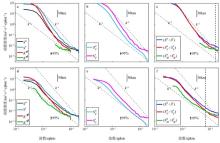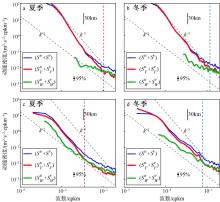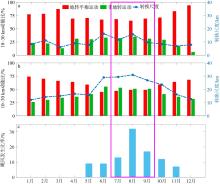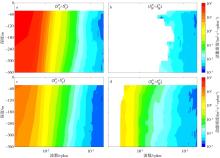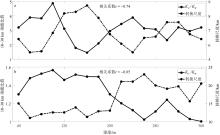| [1] |
BLUMEN W, 1978. Uniform potential vorticity flow. Part Ⅰ: theory of wave interactions and two-dimensional turbulence[J]. Journal of the Atmosphere Sciences, 35(5): 774: 783.
|
| [2] |
BÜHLER O, CALLIES J, FERRARI R, 2014. Wave-vortex decomposition of one-dimensional ship-track data[J]. Journal of Fluid Mechanics, 756: 1007-1026.
doi: 10.1017/jfm.2014.488
|
| [3] |
CALLIES J, FERRARI R, KLYMAK J M, et al, 2015. Seasonality in submesoscale turbulence[J]. Nature Communications, 6: 6862.
doi: 10.1038/ncomms7862
pmid: 25897832
|
| [4] |
CAO HAIJIN, JING ZHIYOU, FOX-KEMPER B, et al, 2019. Scale transition from geostrophic motions to internal waves in the Northern South China Sea[J]. Journal of Geophysical Research: Oceans, 124(12): 9364-9383.
doi: 10.1029/2019JC015575
|
| [5] |
CAO HAIJIN, FOX-KEMPER B, JING ZHIYOU, 2021. Submesoscale eddies in the upper ocean of the Kuroshio extension from high-resolution simulation: energy budget[J]. Journal of Physical Oceanography, 51(7): 2181-2201.
|
| [6] |
CHELTON D B, DESZOEKE R A, SCHLAX M G, et al, 1998. Geographical variability of the first Baroclinic Rossby radius of deformation[J]. Journal of Physical Oceanography, 28(3): 433-460.
doi: 10.1175/1520-0485(1998)028<0433:GVOTFB>2.0.CO;2
|
| [7] |
CHELTON D B, SCHLAX M G, SAMELSON R M, 2011. Global observations of nonlinear mesoscale eddies[J]. Progress in Oceanography, 91(2): 167-216.
doi: 10.1016/j.pocean.2011.01.002
|
| [8] |
CURCIC M, CHEN S S, ÖZGÖKMEN T M, 2016. Hurricane-induced ocean waves and Stokes drift and their impacts on surface transport and dispersion in the Gulf of Mexico[J]. Geophysical Research Letters, 43(6): 2773-2781.
doi: 10.1002/grl.v43.6
|
| [9] |
DALEY R, 1991. Atmospheric data analysis[M]. Cambridge: Cambridge University Press:457.
|
| [10] |
D'ASARO E, LEE C, RAINVILLE L, et al, 2011. Enhanced turbulence and energy dissipation at ocean fronts[J]. Science, 332(6027): 318-322.
doi: 10.1126/science.1201515
pmid: 21393512
|
| [11] |
D'ASARO E A, ERIKSEN C C, LEVINE M D, et al, 1995. Upper-ocean inertial currents forced by a strong storm. Part I: data and comparisons with linear theory[J]. Journal of Physical Oceanography, 25(11): 2909-2936.
doi: 10.1175/1520-0485(1995)025<2909:UOICFB>2.0.CO;2
|
| [12] |
D'ASARO E A, SHCHERBINA A Y, KLYMAK J M, et al, 2018. Ocean convergence and the dispersion of flotsam[J]. Proceedings of the National Academy of Sciences of the United States of America, 115(6): 1162-1167.
doi: 10.1073/pnas.1718453115
pmid: 29339497
|
| [13] |
FIRING E, LIEN R C, MULLER P, 1997. Observations of strong inertial oscillations after the passage of tropical cyclone Ofa[J]. Journal of Geophysical Research: Oceans, 102(C2): 3317-3322.
|
| [14] |
FLAGG C N, DUNN M, WANG DONGPING, et al, 2006. A study of the currents of the outer shelf and upper slope from a decade of shipboard ADCP observations in the Middle Atlantic Bight[J]. Journal of Geophysical Research: Oceans, 111(C6): C06003.
|
| [15] |
KRAICHNAN R H, 1967. Inertial ranges in two-dimensional turbulence[J]. Physical Fluids, 10(7): 1417.
doi: 10.1063/1.1762301
|
| [16] |
KOURAFALOU V H, ANDROULIDAKIS Y S, HALLIWELL JR G R, et al, 2016. North Atlantic Ocean OSSE system development: Nature Run evaluation and application to hurricane interaction with the gulf stream[J]. Progress in Oceanography, 148: 1-25.
doi: 10.1016/j.pocean.2016.09.001
|
| [17] |
MAHADEVAN A, JAEGER G S, FREILICH M, et al, 2016. Freshwater in the Bay of Bengal its fate and role in air-sea heat exchange[J]. Oceanography, 29(2): 72-81.
|
| [18] |
MCWILLIAMS J C, 2016. Submesoscale currents in the ocean[J]. Proceedings of the Royal Society A: Mathematical, Physical and Engineering Sciences, 472(2189): 20160117.
doi: 10.1098/rspa.2016.0117
|
| [19] |
MENSA J A, GARRAFFO Z, GRIFFA A, et al, 2013. Seasonality of the submesoscale dynamics in the Gulf Stream region[J]. Ocean Dynamics, 63(8): 923-941.
doi: 10.1007/s10236-013-0633-1
|
| [20] |
QIU BO, NAKANO T, CHEN SHUIMING, et al, 2017. Submesoscale transition from geostrophic flows to internal waves in the northwestern Pacific upper ocean[J]. Nature Communications, 8: 14055.
doi: 10.1038/ncomms14055
pmid: 28067242
|
| [21] |
QIU BO, CHEN SHUIMING, KLEIN P, et al, 2018. Seasonality in transition scale from balanced to unbalanced motions in the world ocean[J]. Journal of Physical Oceanography, 48(3): 591-605.
doi: 10.1175/JPO-D-17-0169.1
|
| [22] |
ROCHA C B, CHERESKIN T K, GILLE S T, et al, 2016. Mesoscale to submesoscale wavenumber spectra in drake passage[J]. Journal of Physical Oceanography, 46(2): 601-620.
doi: 10.1175/JPO-D-15-0087.1
|
| [23] |
ROSSBY T, FLAGG C N, DONOHUE K, 2005. Interannual variations in upper-ocean transport by the Gulf Stream and adjacent waters between New Jersey and Bermuda[J]. Journal of Marine Research, 63(1): 203-226.
doi: 10.1357/0022240053693851
|
| [24] |
SASAKI Y N, MINOBE S, MIURA Y J, 2014. Decadal sea-level variability along the coast of Japan in response to ocean circulation changes[J]. Journal of Geophysical Research: Oceans, 119(1): 266-275.
doi: 10.1002/2013JC009327
|
| [25] |
TALLEY L D, PICKARD G L, EMERY W J, et al, 2011. Descriptive physical oceanography: an introduction[M]. 6th ed. Amsterdam: Elsevier.
|
| [26] |
WANG DONGPING, FLAGG C N, DONOHUE K, et al, 2010. Wavenumber spectrum in the Gulf Stream from shipboard ADCP observations and comparison with altimetry measurements[J]. Journal of Physical Oceanography, 40(4): 840-844.
doi: 10.1175/2009JPO4330.1
|
| [27] |
ZHAI XIAOMING, GREATBATCH R J, KOHLMANN J D, 2008. On the seasonal variability of eddy kinetic energy in the Gulf Stream region[J]. Geophysical Research Letters, 35(24): L24609.
doi: 10.1029/2008GL036412
|
 ), CAO Haijin3, JING Zhiyou1(
), CAO Haijin3, JING Zhiyou1( )
)




